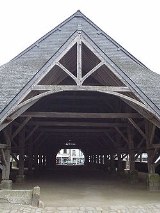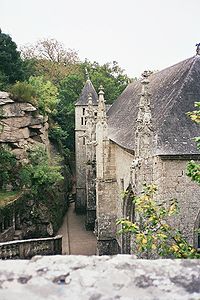
Le Faouët, Morbihan
Encyclopedia
Le Faouët is a commune
in the Morbihan
department of the region
of Brittany in north-western France
.
The Breton language
name of the commune means Beech
forest. The sixteenth century timber market halls are a noted feature of the town and two medieval chapels lies within the boundaries of the commune.
. Traditionally a Breton-speaking area, the French language
became commonly used from the 1950s. The town lies in the valley of the river Ellé
.
, Guiscriff
, Lanvénégen
, Meslan
, and Priziac
.
es was:
Inhabitants of Le Faouët are called Faouëtais.
 The sixteenth century halles, or covered market, remain in use and are a rare surviving example of a large timber structure from the period.
The sixteenth century halles, or covered market, remain in use and are a rare surviving example of a large timber structure from the period.
The chapel of Saint Barbara
is sited on a hilltop overlooking the Ellé. The fifteenth century chapel of Saint Fiacre was recently restored. The polychrome
timber interior was highly regarded, and earned its creator, Olivier Le Loergan, a title of nobility. The stained glass
is also noteworthy. Parts of the interior have suffered considerable damage from insects.
Communes of France
The commune is the lowest level of administrative division in the French Republic. French communes are roughly equivalent to incorporated municipalities or villages in the United States or Gemeinden in Germany...
in the Morbihan
Morbihan
Morbihan is a department in Brittany, situated in the northwest of France. It is named after the Morbihan , the enclosed sea that is the principal feature of the coastline.-History:...
department of the region
Régions of France
France is divided into 27 administrative regions , 22 of which are in Metropolitan France, and five of which are overseas. Corsica is a territorial collectivity , but is considered a region in mainstream usage, and is even shown as such on the INSEE website...
of Brittany in north-western France
France
The French Republic , The French Republic , The French Republic , (commonly known as France , is a unitary semi-presidential republic in Western Europe with several overseas territories and islands located on other continents and in the Indian, Pacific, and Atlantic oceans. Metropolitan France...
.
The Breton language
Breton language
Breton is a Celtic language spoken in Brittany , France. Breton is a Brythonic language, descended from the Celtic British language brought from Great Britain to Armorica by migrating Britons during the Early Middle Ages. Like the other Brythonic languages, Welsh and Cornish, it is classified as...
name of the commune means Beech
European Beech
Fagus sylvatica, the European Beech or Common Beech, is a deciduous tree belonging to the beech family Fagaceae.-Natural range:...
forest. The sixteenth century timber market halls are a noted feature of the town and two medieval chapels lies within the boundaries of the commune.
Geography
Le Faouët/Ar Faoued lies in the historical region of CornouailleCornouaille
Cornouaille is a historic region in Brittany, in northwest France. The name is identical to the French name for the Duchy of Cornwall, since the area was settled by migrant princes from Cornwall...
. Traditionally a Breton-speaking area, the French language
French language
French is a Romance language spoken as a first language in France, the Romandy region in Switzerland, Wallonia and Brussels in Belgium, Monaco, the regions of Quebec and Acadia in Canada, and by various communities elsewhere. Second-language speakers of French are distributed throughout many parts...
became commonly used from the 1950s. The town lies in the valley of the river Ellé
Ellé
The Ellé is a river in the region of Brittany, western France. Its source is south of the town Rostrenen, in the south-west of the department Côtes-d'Armor...
.
Administration
Le Faouët/Ar Faoued is the seat of the Canton du Faouët. The other communes making up the canton are BernéBerné
Berné is a commune in the Morbihan département in Brittany in north-western France.-External links:* * -References:* *...
, Guiscriff
Guiscriff
Guiscriff is a commune in the Morbihan department in Brittany in north-western France.-External links:* * -References:* *...
, Lanvénégen
Lanvénégen
Lanvénégen is a commune in the Morbihan department of Brittany in north-western France.-Demographics:Inhabitants of Lanvénégen are called in French Lanvénégenois.-References:* * -External links:* *...
, Meslan
Meslan
Meslan is a commune in the Morbihan department of Brittany in north-western France.-References:* * -External links:* * *...
, and Priziac
Priziac
Priziac is a commune in the Morbihan department of Brittany in north-western France.-References:* * -External links:* * *...
.
Demographics
The population at recent censusCensus in France
From the mid-17th until the beginning of the 20th century, French censuses became increasingly more frequent and organized. This article focuses on the purposes of the first censuses , how the population was conceived of, and what variables were collected...
es was:
- 1962: 3,039
- 1968: 3,048
- 1975: 3,149
- 1982: 3,177
- 1990: 2,869
- 1999: 2,806
Inhabitants of Le Faouët are called Faouëtais.
Breton language
In 2008, 14,24% of the children attended the bilingual schools in primary education.Tourist attractions

The chapel of Saint Barbara
Saint Barbara
Saint Barbara, , Feast Day December 4, known in the Eastern Orthodox Church as the Great Martyr Barbara, was an early Christian saint and martyr....
is sited on a hilltop overlooking the Ellé. The fifteenth century chapel of Saint Fiacre was recently restored. The polychrome
Polychrome
Polychrome is one of the terms used to describe the use of multiple colors in one entity. It has also been defined as "The practice of decorating architectural elements, sculpture, etc., in a variety of colors." Polychromatic light is composed of a number of different wavelengths...
timber interior was highly regarded, and earned its creator, Olivier Le Loergan, a title of nobility. The stained glass
Stained glass
The term stained glass can refer to coloured glass as a material or to works produced from it. Throughout its thousand-year history, the term has been applied almost exclusively to the windows of churches and other significant buildings...
is also noteworthy. Parts of the interior have suffered considerable damage from insects.

